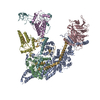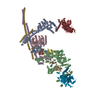+Search query
-Structure paper
| Title | Two assembly modes for SIN3 histone deacetylase complexes. |
|---|---|
| Journal, issue, pages | Cell Discov, Vol. 9, Issue 1, Page 42, Year 2023 |
| Publish date | Apr 19, 2023 |
 Authors Authors | Chengcheng Wang / Zhouyan Guo / Chen Chu / Yichen Lu / Xiaofeng Zhang / Xiechao Zhan /  |
| PubMed Abstract | The switch-independent 3 (SIN3)/histone deacetylase (HDAC) complexes play essential roles in regulating chromatin accessibility and gene expression. There are two major types of SIN3/HDAC complexes ...The switch-independent 3 (SIN3)/histone deacetylase (HDAC) complexes play essential roles in regulating chromatin accessibility and gene expression. There are two major types of SIN3/HDAC complexes (named SIN3L and SIN3S) targeting different chromatin regions. Here we present the cryo-electron microscopy structures of the SIN3L and SIN3S complexes from Schizosaccharomyces pombe (S. pombe), revealing two distinct assembly modes. In the structure of SIN3L, each Sin3 isoform (Pst1 and Pst3) interacts with one histone deacetylase Clr6, and one WD40-containing protein Prw1, forming two lobes. These two lobes are bridged by two vertical coiled-coil domains from Sds3/Dep1 and Rxt2/Png2, respectively. In the structure of SIN3S, there is only one lobe organized by another Sin3 isoform Pst2; each of the Cph1 and Cph2 binds to an Eaf3 molecule, providing two modules for histone recognition and binding. Notably, the Pst1 Lobe in SIN3L and the Pst2 Lobe in SIN3S adopt similar conformation with their deacetylase active sites exposed to the space; however, the Pst3 Lobe in SIN3L is in a compact state with its active center buried inside and blocked. Our work reveals two classical organization mechanisms for the SIN3/HDAC complexes to achieve specific targeting and provides a framework for studying the histone deacetylase complexes. |
 External links External links |  Cell Discov / Cell Discov /  PubMed:37076472 / PubMed:37076472 /  PubMed Central PubMed Central |
| Methods | EM (single particle) |
| Resolution | 2.9 - 4.0 Å |
| Structure data | EMDB-35092, PDB-8i02: EMDB-35093, PDB-8i03:  EMDB-35094: Cryo-EM map of the SIN3L complex from S. pombe in Rxt3 region  EMDB-35095: Cryo-EM map of the SIN3L complex from S. pombe in Prw1 region |
| Chemicals |  ChemComp-ZN:  ChemComp-K: |
| Source |
|
 Keywords Keywords |  DNA BINDING PROTEIN / SIN3 / SIN3S / Pst2 / Clr6 / DNA BINDING PROTEIN / SIN3 / SIN3S / Pst2 / Clr6 /  deacetylase / SIN3L / Pst1 / Pst3 deacetylase / SIN3L / Pst1 / Pst3 |
 Movie
Movie Controller
Controller Structure viewers
Structure viewers About Yorodumi Papers
About Yorodumi Papers








